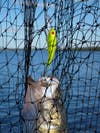An In-Depth Look At Berkley’s New NanoFil Light Spinning Tackle Line
We may earn revenue from the products available on this page and participate in affiliate programs. Learn more › Back...

We may earn revenue from the products available on this page and participate in affiliate programs. Learn more ›

Back in early June, I wrote a glowing tech review here of Berkley’s new NanoFil spinning line. Since then, that product has won an “Innovation of the Year” award at EFFTEX, the European tackle-trade show, and a “Best in Show” award at ICAST, the U.S. fishing trade show. That combination generally marks NanoFil as the hottest new fishing product of any type for the coming year.
I’ve finally gotten extensive time on the water with this new line, which included the fat walleye shown in the photo, so here’s an updated report.
First, at ICAST I grilled Joe Meyers from Pure Fishing/Berkley intensely about just how NanoFil is produced. Meyers is a very talented process engineer, which means he figures out how to make things. Yes, he acknowledged, NanoFil is made from Dyneema filaments (gel-spun polyethylene) like other superlines but is fused into a single filament rather than being braided.
Because polyethylene is basically chemically inert, I suspected that Berkley’s marketing claim of “molecularly linked” fibers to be mostly BS. Meyers more or less acknowledged that, but at the same time would only say “heat, pressure, and some secret sauce” when I pressed further for details. He smiled. I smiled. And I left the Pure Fishing booth still scratching my head.
Next I took my sample of 8-pound NanoFil to Lac Seul in northwestern Ontario, which happens to be one of North America’s hottest walleye lakes. Here F&S Deputy Editor Dave Hurteau and I literally caught all the walleyes we wanted while fishing out of Anderson’s Lodge. Because most walleye fishing is all about sensitivity and being able to feel light bites, it was the perfect place to test a new line.
The new NanoFil was just exceptional. We used two light spinning set-ups; one reel spooled with 8-pound NanoFil, the other with 6-pound nylon mono. The NanoFil performed well on a spinning reel: No tangles, no fuss, no muss, along with definitely enhanced casting distance because of the line’s ultra-small diameter. As we jigged with either live minnows or Gulp! baits in 15 to 20 feet of water, the no-stretch NanoFil gave a superb feel for both the bottom rocks and the gentle tap-tap of a taking fish. By contrast, the other reel filled with light, stretchy mono felt like total mush.
When we chose instead to troll small, deep-diving crankbaits, NanoFil was again a huge advantage. First, the fine diameter gave trolled baits added depth because the line itself has less water resistance. Second, the line’s no-stretch aspect let me feel every wiggle of a waggling chartreuse Wally Diver along with every little rap from a striking walleye. Here again, light mono–while it still worked–was nowhere nearly as successful.
To say I’m sold on the new NanoFil would be an understatement. It’s just a fantastic product for use on light spinning tackle. It’s not cheap at $20 for a 150-yard spool, but it’s worth every penny. You can read more about the line on Berkley’s website.